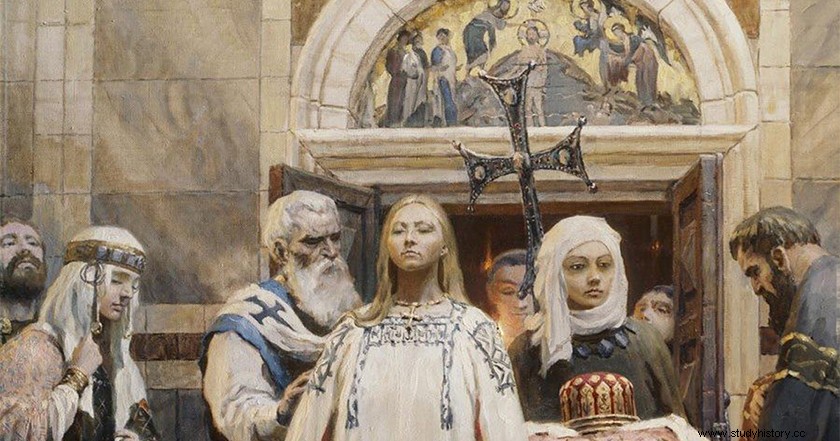
Gosvinta is another great example that history It is not written by women. She, without a doubt, was one of the most important characters in the history of the Visigoth Kingdom , not only in the 6th century, but possibly during the entire period of survival of the great kingdom of Toledo. But being an energetic, determined and courageous woman in the political affairs of the sixth century, without assuming the role of submissive and respectful wife of her, was an attitude difficult to forgive.
Gosvinta Origins. Balta princess?
Gosvinta lived through one of the most convulsive periods in the history of the Visigoth people. A people that carried in a collective memory the memory of wandering centuries, traveling through much of Europe from the Baltic to the Mediterranean. But in the middle of the sixth century the story was quite different. They had been awarded by Rome as heirs to one of the richest provinces of the late Western Empire. But like the vast majority of awards, you had to finish earning it.
When Gosvinta enters the history of the Visigoth people, she is immersed in the beginnings of the reunification of the ancient territories of Roman Hispania . In the northwest, the Suebi had already held sway for a century and a half before. To the north, the less Romanized peoples, Asturian, Cantabrian and Basque, wanted to continue sheltered behind the Cantabrian Coast, in a kind of political independence from the rest of the peninsula. To the southeast the danger was called Byzantium, which continued to exercise control of the Spaniae province. Finally, note that even the former capital of Roman Baetica lived outside the political control of the Visigoths, dominated by the high Hispano-Roman nobility.
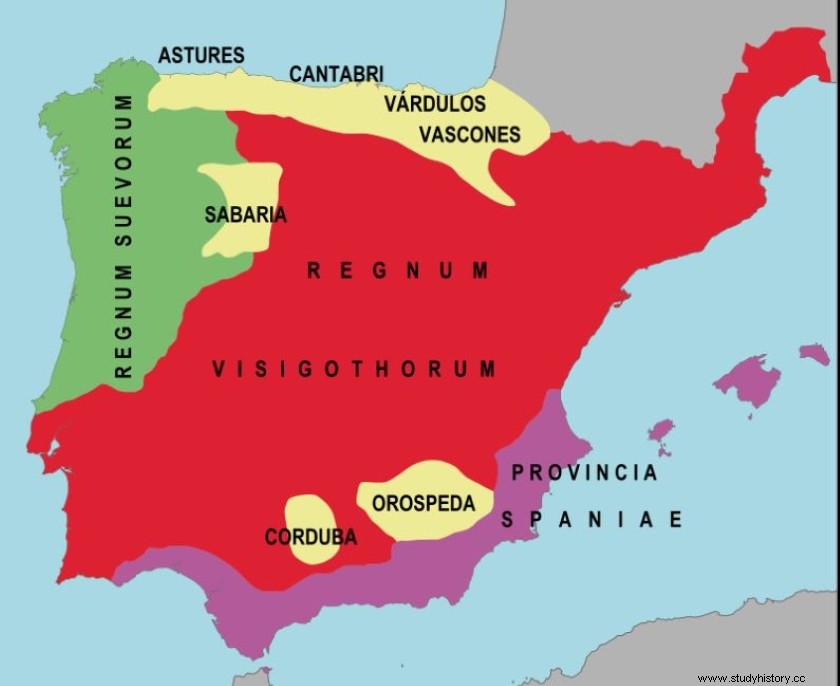
Map of the Peninsula around the year 560
For such an enormous task, he who wanted to be king of the Visigoths had to unite the greatest consensus and support of the Visigothic nobility. That is without a doubt the role assigned to Gosvinta . Although his origin is unknown, all historiography assigns him a position of honor among the high Visigothic nobility, even a large part of it assigns him the role of heiress of the Baltic family. A family that had directed the plans of the Roman people, from Alaric I (395-410) the plunderer of Rome. But a family that, despite being very significant, had lost control of the Visigothic crown after the defeat at the Battle of Vouillé (507), in central France. From that moment on, the Ostrogoths took over the Visigothic crown, and the defeated Balts emigrated from Septimania to Hispania.

Battle of Vouille
Visigoth queen with Atanagildo.
Little is known about Gosvinta's first reign. Beyond the fact that she was married to Atanagildo, and as far as we know she had two daughters. Atanagildo became king of the Visigoths after a bloody civil war with Agila I. We also do not know if the marriage between the two was before or after that war, but what is important is that the marriage gave Atanagildo political, social, and economic strength. and military to bring peace to the Visigoth people. Period that he took advantage of to strengthen Toledo as the capital of the Hispanic Visigothic kingdom.
Another aspect that we know was the need to seek a lasting peace, and even an ally on the other side of the Pyrenees. The Franks had propitiated, as we have seen in Vouillé, one of the most painful defeats in Visigothic history. The two daughters of Gosvinta, and supposedly of Atanagildo, headed for the Frankish kingdoms in Merovingian hands. Galsvinta married Chilperic of Neustria, and her sister Brunequilda with Sigibert of Austrasia .
As we have already pointed out, the sources are very scarce from this period, but even some that are rejected as true can lead us to some interesting reflection. I am referring to a poem written by Venancio Fortunato, bishop of Poitiers, after Galsvinta's death ordered by her own husband Chilperic. In the said poem we are described the moment in which the Frankish envoys arrive in Toledo to pick up Galsvinta. She is clinging to her mother, refusing from her to marry a man she doesn't even know. While queen Gosvinta cries out to heaven questioning him; Why do you have to take her to distant lands, where I will no longer be her mother?
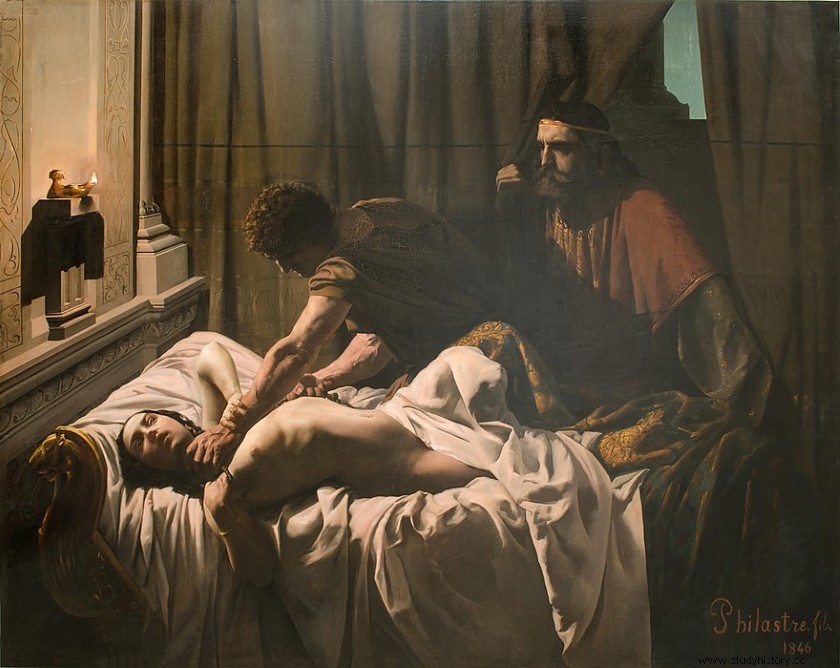
Galsvinta's death.
Certainly, this source is rejected, because Gosvinta's attitude is not very consistent with the rest of the sources that indicate her wandering through history. At this point, we can ask ourselves two things:Why does historiography try to dehumanize the Visigothic queen? Any mother, she would not have acted in a similar way?
Gosvinta with Leovigildo.
Here we can find a first answer to the previous questions. Leovigildo is the great military restorer of the Hispania that the Romans had left behind. Gosvinta, his wife, was one of the main political rivals at the court of Toledo.
Although we go by parts, in the previous point we have left Gosvinta married to Atanagildo. Well, as strange as it may seem and if nobody tells us otherwise, the Visigothic king died a natural death . Yeah, it's weird, but that's what the sources say. After the death of Atanagildo, there was a return to the noble war. A short war that lasted about five months, until the high Visigoth nobility accepted the appointment of Liuva, one of the most important nobles of Narbonne. This decides shortly after the incorporation of his little brother to the government of Hispania and sends him to the headquarters of Toledo. It was the year 569.
It seems inevitable to think that, in those five months, more than a great military battle, a fight was forged in the meetings of the Visigoth high nobility. In the same way that it is not so far-fetched to think that, in one of those meetings, the marriage between Leovigildo and Gosvinta was agreed upon. Only the dynastic union of the two most important Visigothic families of the time could lead to the Visigothic state, to the internal peace necessary to gain total control of Roman Hispania. The control was carried out during the prolific reign of Leovigild, but it was evident that Gosvinta was not going to give up her part of her pie .
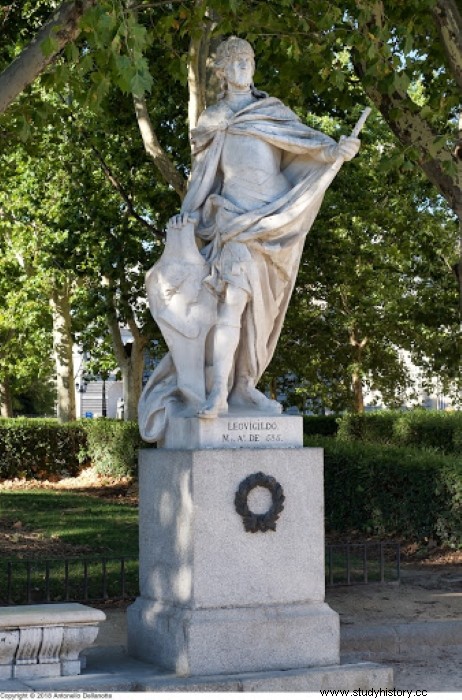
Leovigildo.
We won't go into Leovigild's conquests much. But it is clear that the military power of the new Visigoth king was based on the strength provided by that marriage of convenience. The political faction in Hispania that supported Queen Gosvinta was still superior to that which supported Leovigild . The rest of the Hispanic powers fell consecutively, Córdoba, Spaniae, and the Swabians succumbed to a united Visigothic kingdom during the reign of Leovigildo
The Visigoth kingdom of Hispania finally enjoyed internal peace. Everyone promised them happy.
Guilty of Hermenegild's revolt?
But the error of the year 579 arrived. And we will certainly never know who made it. The truth is that, at first, the intention seems to be along the political line forged by the Visigothic kingdom, of alliance through the marriages of the two main factions of the Visigothic nobility .
Let me explain. Leovigildo brought two sons to the marriage, Hermenegildo and Recaredo . Of her mother we know nothing, whether she was disowned by Leovigild or whether she died before Gosvinta's arrival. The truth is that there is no evidence that the relationship between the children of Leovigildo and Gosvinta was negative, rather the opposite. On the other hand, let us remember that Gosvinta had had two daughters. One of them had been killed by her husband, the other, Brunequilda, had managed to establish herself on the throne of the Merovingian kingdom of Austrasia. There she had had a beautiful daughter, Ingunda, who was now twelve years old and therefore she could already be married. The chosen one was the youngest son of Leovigildo.
The marriage between Hermenegild and Ingunda took place in the year 579 . As they were two children, 15 and 12 years old respectively, their first home had to be the court of Toledo. After a few days the problems begin. Gosvinta knew perfectly well that any internal problem could destabilize the Visigoth government, and religion was a priority issue in any early medieval court .
The kingdom of Toledo was still Arian, yes, before a majority Catholic population, hence Gosvinta quickly sensed the problem that could come upon them. Ingunda, the beautiful twelve year old girl decides that she wants to remain Catholic . Her mother had been forced to renounce Arianism, and they were not going to do the same to her. Not even if she asked for it, her grandmother herself was going to renounce the Catholic religion.
The story is told to us by the Catholic bishop and Gallic historian Gregory of Tours.
“Gosvinta did not hesitate to resort to violence against her granddaughter. He grabbed her by the hair to throw her to the ground and there she kicked him everywhere. All bloodied, she had her stripped naked and thrown into her baptismal font, to rebaptize her to the Arian rite ”
Not even with those, the young beautiful and wayward Gallic princess, granddaughter of Gosvinta, renounced Catholicism. Leovigildo tried to mediate the situation by sending the couple to Seville. There Hermenegildo was baptized into Christianity, and with the support of the Hispano-Roman Catholic nobility took up arms against his father. The revolt started in the year 581, and only one aspect has blamed Gosvinta for it; the child fathered by Ingunda, her name a declaration of intent, Atanagildo, the same as her first husband.
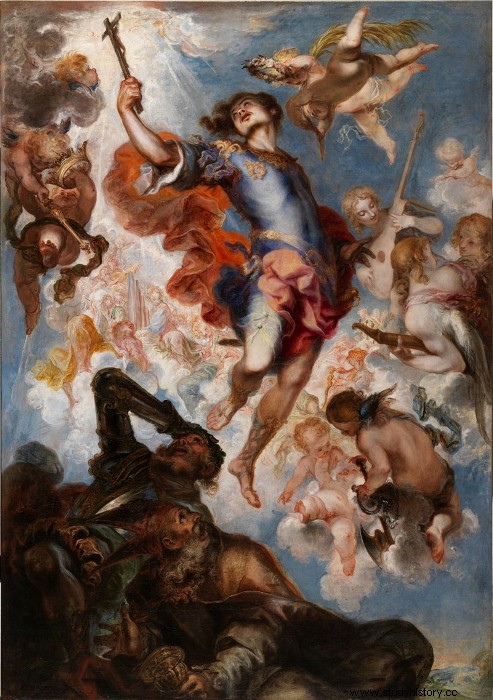
Hermenegildo was made a Saint by the Catholic Church
Gosvinta's intentions can be sensed. At stake was the eternal dispute between the two main Visigothic families of Hispania. But of course, the culprit of that revolt was called Gosvinta?
Well, on paper the answer must be complex. In addition, before continuing we can ask ourselves a couple more questions: Why is there no indication that Leovigildo will punish his wife, after finishing Hermenegildo ? What was Gosvinta doing, a staunch Arian, defending a rebellion with a Catholic background ?
Gosvinta staunch Arian.
Leovigild captures Hermenegild around the year 584, sends him to Levante, and dies in prison in the ancient Roman city of Tarraco. Leovigildo himself died in the year 586, we know little or nothing about the causes. What we know is that he is at the head of the Recaredo kingdom. The only son of the great reunifier of Roman Hispania should not have had many problems for the high nobility to trust him. In addition, the conquests of his father brought money to the Visigoth coffers and great military and social recognition. Even so, his first decision at the head of the Visigoth kingdom is to declare Gosvinta queen mother, what need did he have?
Another answer without much consensus, since the most plausible is that Recaredo allied himself with Gosvinta to reinforce again the necessary alliance with the Franks, after the offense of the Visigothic kingdom of leaving to die his princess Ingunda in exile on the way to Constantinople.
But Recaredo's plans did not contrast with Gosvinta's. Recaredo is firmly determined to end what his brother had started, to change the creed of the Visigothic kingdom of Toledo. Both had been aware of the enormous opportunities that their Catholic baptism would bring, to find the definitive support of the old Hispano-Roman nobility. In the Third Council of Toledo, held in the year 589, he adjures from Arianism to embrace Catholicism.
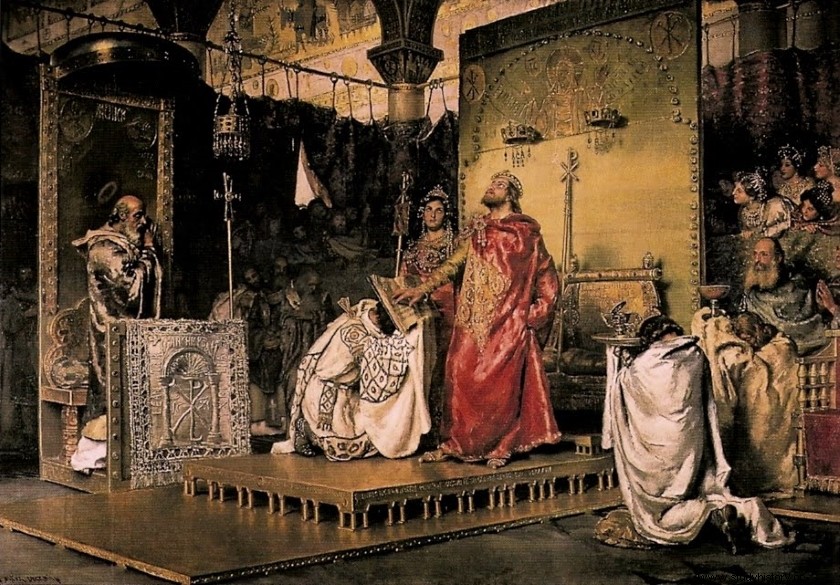
Recaredo conversion.
But Gosvinta was born an Arian and intended to die an Arian if she had to . Although Arianism had lost much strength, he sought the alliance of the Arian nobility supported by the bishop of Toledo, Uldilda. A fight took place, but the sources are not clear about the dimensions of it. The truth is that King Recaredo's troops defeated the insurgents. Of Bishop Uldilda we know that he was banished but pardoned, behind said pardon lies Recaredo's attempt to attract the remnants of the Arian Church to the cause of Catholicism. We don't know anything more about Gosvinta, we don't know if she was murdered or if she killed herself after the defeat .
Afterword.
As we have seen, with the string of unresolved questions that have been arising in this article, we know much less about Gosvinta than it might seem at first glance. She certainly was the wife of two Visigothic kings, and the adoptive mother of another. She is the mother of two daughters and the grandmother of a very Catholic Frankish princess. We can also deduce without fear of being wrong that she was the main head of an aristocratic Visigothic lineage in clear decline. Finally, note that she was a convinced Arian.
Queen Gosvinta broke the mold, participating in the political life of the Visigoth Kingdom. That was unforgivable . She was judged historically by Catholic historians, both Juan Biclaro and Gregorio de Tours, they did not forgive her that once again, and there have been many in history, that a woman like her tried to stand out in a world of men.
On how historiography has treated her, I leave you the sentence with which the Royal Academy of History closes her biography on Gosvinta:
“Fortunately for everyone, Gosvinta died in Toledo in the second half of that year of death, apparently natural.”
Recommended reading.
A few days ago Editorial Edhasa published the winner of its IV Edition of its Historical Narrative Awards, the winner was Jose Soto Chica , with his work entitled "The God Who Inhabits the Sword".
It should be noted that José Soto Chica is one of the current historians who best knows the period of the Visigoth Kingdom. His novel set in the reign of Leovigild can make us know Queen Gosvinta a little better. I haven't enjoyed it yet, I hope to solve it soon, to complete this information.

The God who inhabits the sword in Historioteca.
More info:
ANTIQUE AND CHRISTIANITY, HISTORICAL MONOGRAPHS ON LATE ANTIQUITY, Series directed by Dr. D. Rafael González Fernández
«VIRILES» WOMEN IN VISIGOTHIC HISPANIA. THE CASES OF GOSVINTA AND BENEDICTA. Mª Rosario Valverde Castro.
